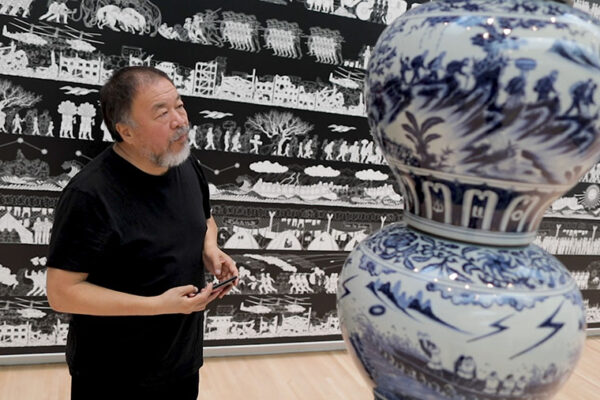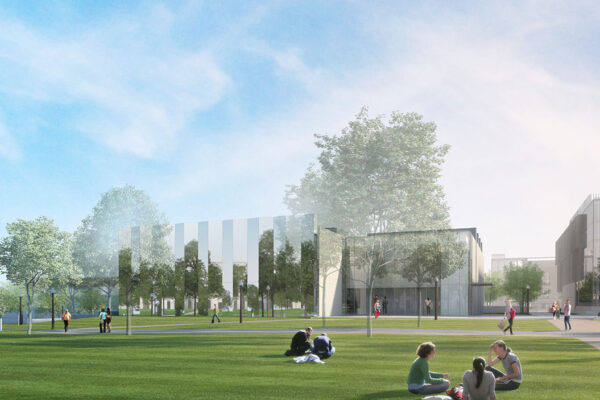
This fall, the newly expanded and renovated Mildred Lane Kemper Art Museum at Washington University in St. Louis will reopen with a major exhibition of work by Ai Weiwei. The renowned Chinese dissident artist and activist is internationally known for rigorous, compassionate and complex artworks that address themes of political, ethical and social urgency. Designed by the artist and curated by Sabine Eckmann, the William T. Kemper Director and chief curator of the Kemper Art Museum, “Ai Weiwei: Bare Life” will be on view from Sept. 28 through Jan. 5, 2020.
“Ai Weiwei: Bare Life” will feature roughly three dozen artworks, some in a series, created over the last two decades in a wide variety of mediums — among them sculptures, installations, photographs and films. A selection of newly conceived large-scale and site-specific projects will be placed in dialogue with some of Ai’s most iconic works and several major artworks never before exhibited in the United States. Together, these objects will provide new insight into Ai’s abiding concern for human rights and the global condition of humanity while showcasing his profound engagement with Chinese culture past and present — especially the radical shifts that have characterized China in the new millennium.
The exhibition, which is organized into two thematic sections, takes its title from the writings of the Italian philosopher Giorgio Agamben, who has long examined the notion of bare, unprotected life and its manifestations throughout human history. In recent years, Agamben’s ideas have gained new force as approximately 70 million people have been displaced from their homelands and deprived of basic human rights.
The first section, “Bare Life,” encompasses artworks visualizing the effects of the global refugee crisis as well as Ai’s investigation into Chinese human rights violations in connection with the 2008 Sichuan earthquake. The second section, “Rupture,” alludes to the German-Jewish philosopher Hannah Arendt’s influential writings about modernity’s break from tradition. It comprises artworks that represent Ai’s creative engagement with China’s cultural legacy, from the radical erasures of the Cultural Revolution (1966–76) to the rapid globalization and economic reforms that have marked the beginning of the 21st century.
“Over the last decade, the Kemper Art Museum has explored the interconnections between art, especially conceptual art, and politics,” Eckmann said. “Continuing in this trajectory, ‘Ai Weiwei: Bare Life’ is focused on Ai’s creation of images that reconfigure the past in the present, employ a radical form of realism for political critique and elevate into the realm of visibility those whose humanity has been ignored. We are extremely honored to be able to present the work of one of the most important artists and humanitarian voices of our time.”
Adds Ai: “The exhibition at the Kemper Art Museum will be my first major institutional exhibition in the Midwest. It will also be my first major exhibition created under an academic framework. The exhibition is separated into two sections — ‘Bare Life’ and ‘Rupture’ — and the process of selecting the works and curating the show with Sabine Eckmann has been intense, but also precise and meaningful.”

‘Bare Life’ section
A monumental new wallpaper mural will take advantage of the voluminous space of the museum’s vaulted Saligman Family Atrium. Measuring approximately 65 feet long and 36 feet high, the as-yet-untitled installation visualizes Ai’s research on bombs developed between World War I and the present day by the United States, Germany, Great Britain and other countries. Employing a minimalist and emotionally detached language, the mural powerfully invokes the brutality and inhumanity of industrial warfare and the immense scale of its destruction.
Entering the museum’s Barney A. Ebsworth Gallery, visitors will encounter the mesmerizing “Forever Bicycles” (2019), a new, large-scale, site-specific installation that dominates the center of the room. Composed of 720 Forever bicycles — an iconic Chinese brand — the artwork is a readymade of sorts, diagonally bisecting the gallery while also creating a monumental arch through which visitors can pass.
To one side of “Forever Bicycles,” viewers will find a series of projects relating to victims of the devastating earthquake that struck Sichuan Province in 2008 and to Ai’s persecution by Chinese authorities for his outspoken political activism sparked by the event. Through sculptures, videos and installations, Ai explores the Chinese government’s insufficient response to the quake, which resulted in the collapse of substandard school buildings and the deaths of an estimated 90,000 people, including more than 5,000 children. Among these works is the semiabstract sculpture “Forge Bed” (2008–12), here making its U.S. debut. The work is formed from iron rebar segments that were shaped to replicate twisted rebar Ai found in Sichuan following the earthquake.
To the other side, viewers will find artworks reflecting Ai’s deep concern for the welfare and dignity of displaced people around the world. “Tear Gas Canisters” (2016), also making its U.S. debut, consists of altered tear gas cans that were used by police against refugees. The “Odyssey” (2016) frieze, which covers two of the gallery’s walls, is an immense wallpaper installation narrating the journey of those forced to flee their homelands, including representations of war, ruins in the wake of war, traveling on land, crossing the sea, refugee camps, and protests in host countries. Contemporary images are interspersed with figures and elements from ancient Greek and Egyptian art, Renaissance sculpture, and 19th-century Japanese woodblock prints. Through these hybrid artistic languages Ai insists on the universal urgency of human coexistence in a shared world while bringing empathy and visibility to precarious lives.
Other projects in the section use the medium of film to focus on the effects of war and displacement across the world, including the videos “Idomeni” (2016), “Laziz” (2017) and “Calais” (2018). In addition, the museum will host public screenings of Ai’s longer documentary films about the refugee crisis, including “Human Flow” (2017) and the brand-new “The Rest” (2019).

‘Rupture’ section
Entering the museum’s Garen Gallery, visitors will encounter a range of artworks in which Ai engages with historical Chinese artifacts and explores China’s complex relationship to its past and its rapid transformation into a globalized country.
“Through” (2007–08), a monumental installation not previously exhibited in the United States, is constructed from immense wooden pillars sourced from demolished temples. Crisscrossing the gallery at sharp diagonals, these beams intersect at various junctures and penetrate the tops of Qing-dynasty (1644–1912) tables, forming a complex network of interdependent structures that condense China’s ruptured history.
The availability of such architectural remnants speaks to the scale of contemporary development, which has destroyed many historically significant buildings. Through evolved from a series of furniture works Ai began in 1997, employing skilled artisans to reassemble antique furniture and fragments into new configurations using traditional joinery techniques. Other iconic works on view from this series are “Table with Three Legs” (2006) and “Grapes” (2011).
Nearby, the triptych “Dropping a Han Dynasty Urn” (2015), constructed from LEGO bricks, depicts Ai in the deliberately destructive act of dropping a Han-dynasty (206 BCE–220 CE) urn. The artwork is based on a set of three photographs taken in 1995 and, like much of Ai’s work, investigates the complex and artistically generative relationship between destruction and creation. Ai’s performative iconoclasm can be understood both as an ironic reenactment of the Cultural Revolution and as a metaphor for China’s break with its traditions and values.
Positioned near the triptych, and also making its U.S. debut, is “Feet” (2010), a display of found relics dating back to the sixth century. The work comprises ten pairs of stone feet originally belonging to Buddhist sculptures likely destroyed during a suppression of Buddhism in the ninth century. Here, Ai leaves the feet unaltered, displaying them as readymades or found objects to underscore the act of iconoclasm already perpetrated upon them.
Other works on view document more recent changes to China’s built environment. “Souvenir from Shanghai” (2012), a large-scale sculpture, is composed of rubble from Ai’s Shanghai studio, which was demolished in 2011 by the city government. “Provisional Landscapes” (2002–08), a wallpaper created from a series of more than 100 photographs, depicts urban spaces in transition as older, traditional buildings are destroyed to make way for new construction. The conceptual videos “Beijing 2003” (2003), “Chang’an Boulevard” (2004), “Beijing: The Second Ring” (2005) and “Beijing: The Third Ring” (2005) reveal the city’s shifting urban landscape while preserving a particular moment in time.

Publication
The accompanying catalog presents the artist’s work in dialogue with theoretical texts by the philosophers Giorgio Agamben (b. 1942) and Hannah Arendt (1906–1975) alongside three interpretive essays that illuminate the artist’s work on the universal human condition, his engagement with historical Chinese artifacts, and his critical consideration of the effects of globalization. The book includes a new essay on human rights by Ai and an interview in which he discusses his artwork and activism. With over 100 images, including installation photographs of the exhibition, the publication is designed by Lorraine Wild, Green Dragon Office, Los Angeles, and distributed by the University of Chicago Press.
About Ai Weiwei
Ai was born in Beijing in 1957. The following year, his family was sent to a labor camp in the northeastern province of Heilongjiang, then spent 16 years exiled in the western province of Xinjiang. The family resettled in Beijing in 1976, after the death of Mao Zedong and the end of the Cultural Revolution. Ai studied animation at the Beijing Film Academy but spent most of the 1980s and early ’90s residing in New York. There he began making conceptual artworks as well as photographs of political unrest, police violence and homeless people—concerns that remain central to his practice.
Returning to China in 1993, Ai helped to establish the Beijing East Village artist colony, the China Art Archives & Warehouse independent art space and the architecture studio FAKE Design. He collaborated with Herzog & de Meuron on the “Bird’s Nest” stadium for the 2008 Beijing Summer Olympics. Through his investigations into the circumstances prior to and following the 2008 Sichuan earthquake, he emerged as a prominent government critic and was arrested in 2011. He remained under constant surveillance until 2015, when his passport was returned to him and he could leave the country. He currently lives and works in Berlin.
Ai’s work has been exhibited at major venues around the world, including recently at the Israel Museum in Jerusalem (2017), the National Gallery Prague (2017), the Sakıp Sabancı Museum in Istanbul (2017), the Taipei Fine Arts Museum (2011), and the Tate Modern in London (2010). In 2017, he was commissioned to create a citywide installation, “Good Fences Make Good Neighbors,” for New York City’s Public Art Fund. His many honors include Amnesty International’s Ambassador of Conscience Award (2015), the inaugural Václav Havel Prize for Creative Dissent (2012), and the Chinese Contemporary Art Award for Lifetime Achievement (2008).
Exhibition support
Support for exhibitions at the Mildred Lane Kemper Art Museum is provided by the William T. Kemper Foundation, Nancy and Ken Kranzberg, Elissa and Paul Cahn, the Hortense Lewin Art Fund, and members of the Kemper Art Museum.
To learn more, visit Kemperartmuseum.wustl.edu, or follow the museum on Twitter, Facebook and Instagram.


